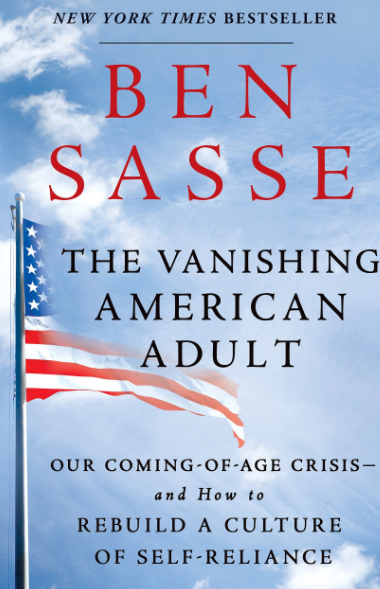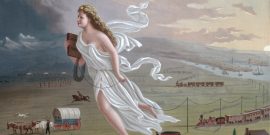America's Delayed Adolescence in the Digital Economy
American grit was once thought permanent. With the right stuff, a single person with a few kindred spirits could find salvation, start a business, run for office, or settle the frontier. Alexis de Tocqueville famously described that practical, spirited American as “plunging into the wilderness of the New World with his Bible, ax, and newspapers.”
Many presumed that our knowhow was innate. “Every man’s condition is a solution in hieroglyphic to those inquiries he would put. He acts it as life, before he apprehends it as truth,” wrote Ralph Waldo Emerson (“Nature,” 1836). Since Americans only needed to intellectually discover the inner strength they already possessed, Emerson’s prescription for “Self-Reliance” (1841) was: “Trust thyself.”
But simply following the dictum “To thine own self be true” is unreliable if thine own self is untrustworthy. Emerson’s ilk presupposed contingent practices that mature us into wise, industrious adults. Adulthood dwindles in today’s America as labor, health, and mobility crises mark what has been called “our miserable 21st century”—wage stagnation, male joblessness, and opioid carnage combine with declines in birthrates, life-longevity, marriages, civic and religious engagement, along with increases in suicides and public distrust in institutions. With old conditions adrift, moralists face difficulties when delayed adolescence produces unreliable selves.
Enter Ben Sasse, the Yale-trained historian and U.S. Senator (R-Neb.). His new book concerns American millennials who tarry in Neverland and encounter bad teachings as they leave it, as adolescence extends well past college into lives of postponed work, property acquisition, marriage, and childrearing. In The Vanishing American Adult (2017), he offers a history of work and childhood, critiques cultural catechesis, and advises parents on how to combat these trends. Charles Murray calls it “a handbook for cultural revolution.” Such praise has some warrant, but some insufficiencies still persist in it.
According to Sasse, delayed adolescence intensified as economies became digital, mirroring another cultural shock when 20th century Americans left rural farms for industrial cities. Although people worried about the health of civil society, they formed new communities in urban ethnic neighborhoods. Children matured in many spheres outside of the public schools that had been created to mitigate industrial disorder. We presupposed homes as intergenerational units, churches as moral instructors, and towns as intimate nests. Now, our moral resources are fewer as government peer-education supplants other local means to educate generations.
The author blames John Dewey for schools’ educational monopoly. As counterpoints he offers a philosophical odd couple: Saint Augustine and Jean-Jacques Rousseau. Augustine describes our inherent fallenness as self-love manifested in worldly attachments. His lesson is that sin originates first within souls before manifesting in societies. Rousseau, meanwhile, argues that the knowledge to live freely comes tacitly by experience, not technically by textbooks. Children discover life’s natural advantages and disadvantages by experiment and failure. Augustine’s sober realism and Rousseau’s free-range empiricism are lacking in the miseducation received by our young.
Adolescence separates physical maturity from responsibilities to enable moral maturation. This artificial phase works well, within limits, but it has been prolonged as laborious, free-range, and analog childhood has disappeared. As a result, souls starve for the challenges on which future happiness depends. Sasse documents the problems well, and sketches some solutions through anecdotes and prudent proposals: end age segregation; learn the value of “real work” as early as possible; relearn distinctions between want and need, consumption and production; serendipitously travel, read great books, and expose Americans to better civic education that they may grow up to be patriots.
The Vanishing American Adult accessibly situates our maturity crisis but underestimates questions of nationality, locality, and morality. During the Gilded Age of industrial transition and peak immigration, our civil religion bound the nation through mandated school attendance and coinage of the term “the Founding Fathers.” Sasse suggests that, given the severe dysfunction in Washington and “safe spaces” on the college campus, we should teach federalism and civil liberties more. “Make America an Idea Again” he proclaims, as a “creedal nation”—without qualification.
But cultural catechesis takes more than abstract ideas. Our universal ends—liberty and justice for all—have particular means, which is to say that a specific language, land, and political history constitute the country. Sasse says American exceptionalism means “everyone understands themselves to be a creedal minority.” Does that mean that America is, paradoxically, a creedal nation of creedal minorities? Or does it have an embodied context, which predicates how a fractured republic can say, “We, the people”?
In three ways, the political theorist Joshua Mitchell identifies, a nation historically justifies its union: liberalism, ethnicity, and covenant. The American glory is that diverse peoples and sects may live peacefully as public citizens under equal rule of law. But our national commitment to “All men are created equal” cannot alone bind a polity—that creed needs other truths as well.
Lincoln, for example, spoke of national creed in a multifaceted way. As the heroes of the American Revolution died, he warned in his Lyceum Address (1838), unity must be acquired by constitutional devotion: “reverence of the laws” as “the political religion of the nation” lets all “unceasingly sacrifice upon its altars.” He also appealed to the “mystic chords of memory stretching from every battlefield and patriot grave to every living heart and hearthstone all over this broad land.” In our civil religion, historical memory is rooted in love of home, for paired with our liberal tradition is our covenantal tradition, as Gettysburg extends that mystical chord in a war diagnosed as divine punishment for slavery but which allowed providential reconciliation.
Our covenant mediates individual initiative and universal dignity in what John Winthrop calls “federal liberty,” within the covenants between God and men in the moral law and among men in political constitutions. As Daniel Elazar explains, a congregation of free persons under transcendent authority pledge their loyalty “beyond that demanded for mutual advantage, actually involving the development of community among the partners to it.” The mutual pledge of lives, fortunes, and sacred honor in the Declaration of Independence exemplifies this model. And that tradition enables the civic friendship which, among other sources, sustains our liberalism.
This federal liberty, as Sasse perceives, involves local governance. Tocqueville’s Democracy in America (1835), which he cites, spends 12 pages on the American Founding but 40 on the Puritans. Why? Like Rousseau, Tocqueville prizes tacit knowledge found in practices of living freely over technical knowledge in documents. To paraphrase Emerson, we acted liberty in life before apprehending its abstraction. Sasse ably speaks for public spiritedness and chronicles the loss of American locality. But when delayed adolescence marks our lost sense of the common good, civic virtue needs more than industry and family. It takes neighborliness. To be sure, we need more governance in every American city except one—Sasse ably champions federalism but more discussion of how to renew local loves would have benefitted his book.
Teddy Roosevelt is its hero, Peter Pan its villain. In lionizing TR, Sasse presents the good life as “strenuous”—perhaps too much so. Sasse’s TR models how to counteract our national sloth. His TR is correct but incomplete. Consumption kills time, he says, but recreation redeems time. We rest to become productive citizens again. Sasse prefers “recreation” to “leisure,” which for him connotes idleness. Yet, conceived another way, leisure is the basis of culture, which Sasse underestimates.
Thus when he likens his grandparents’ hardiness to Boxer, the dutiful horse in George Orwell’s Animal Farm, he has not taken in that Boxer is a “noble dupe” working until his injuries get him sold to a glue factory, as B.D McClay has noted. Work is virtuous but a world filled only with work is a drab prospect. Perhaps both Sasse and McClay are correct.
Millennials seem to lack both leisure and sanctifying struggles. This duality mirrors the nationalist and localist malaise as misunderstandings of rooted commitment. Millennials are estranged from the thrill of commitment, the festivity of the vow, the love for place and nation—what Chesterton calls the “transfiguring self-discipline” known only to soldiers, ascetics, and married lovers. We need again the virtues, which take great effort to become easier over time, as good habits become second nature. In that way work can become leisure. Thus, Aristotle says, we do non-leisurely activities in order to be able to engage in leisurely ones.
If virtue were to only be strenuous, though, vocation and recreation would never meet. That schools without liberal learning also displace work is no coincidence. Not without reason did Tocqueville call despoiled leaders “schoolmasters” who keep a democracy of clerks “in perpetual childhood.” Peter Pan would live perfectly happily under soft despots, but not from an excess of leisure.
Tocqueville also advised the moralists and the elected leaders of democratic nations to introduce into public life a long-term view. This book by a senator with sound things to say about raising future adults scores on both counts. Hopefully, parents read it.



